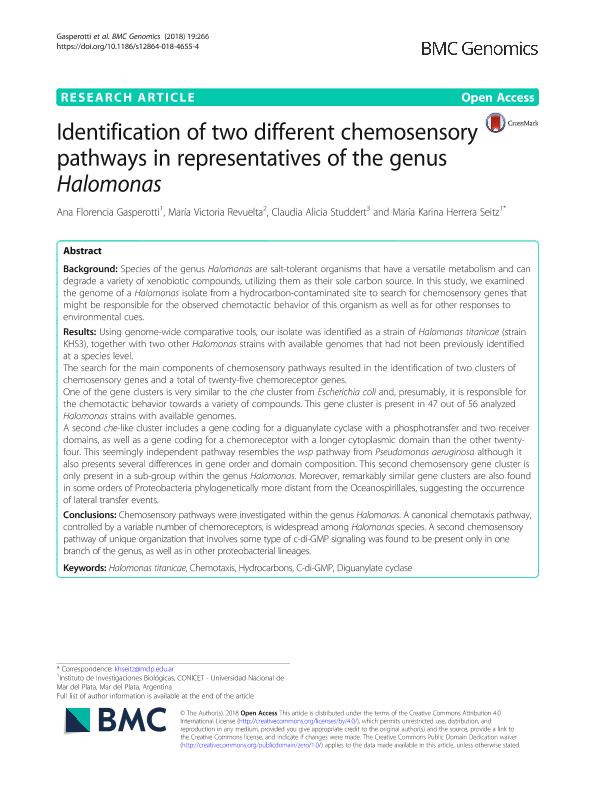Artículo
Identification of two different chemosensory pathways in representatives of the genus Halomonas
Gasperotti, Ana Florencia ; Revuelta, María Victoria
; Revuelta, María Victoria ; Studdert, Claudia Alicia
; Studdert, Claudia Alicia ; Herrera Seitz, Karina
; Herrera Seitz, Karina
 ; Revuelta, María Victoria
; Revuelta, María Victoria ; Studdert, Claudia Alicia
; Studdert, Claudia Alicia ; Herrera Seitz, Karina
; Herrera Seitz, Karina
Fecha de publicación:
04/2018
Editorial:
BioMed Central
Revista:
BMC Genomics
ISSN:
1471-2164
Idioma:
Inglés
Tipo de recurso:
Artículo publicado
Clasificación temática:
Resumen
Background: Species of the genus Halomonas are salt-tolerant organisms that have a versatile metabolism and can degrade a variety of xenobiotic compounds, utilizing them as their sole carbon source. In this study, we examined the genome of a Halomonas isolate from a hydrocarbon-contaminated site to search for chemosensory genes that might be responsible for the observed chemotactic behavior of this organism as well as for other responses to environmental cues. Results: Using genome-wide comparative tools, our isolate was identified as a strain of Halomonas titanicae (strain KHS3), together with two other Halomonas strains with available genomes that had not been previously identified at a species level. The search for the main components of chemosensory pathways resulted in the identification of two clusters of chemosensory genes and a total of twenty-five chemoreceptor genes. One of the gene clusters is very similar to the che cluster from Escherichia coli and, presumably, it is responsible for the chemotactic behavior towards a variety of compounds. This gene cluster is present in 47 out of 56 analyzed Halomonas strains with available genomes. A second che-like cluster includes a gene coding for a diguanylate cyclase with a phosphotransfer and two receiver domains, as well as a gene coding for a chemoreceptor with a longer cytoplasmic domain than the other twenty-four. This seemingly independent pathway resembles the wsp pathway from Pseudomonas aeruginosa although it also presents several differences in gene order and domain composition. This second chemosensory gene cluster is only present in a sub-group within the genus Halomonas. Moreover, remarkably similar gene clusters are also found in some orders of Proteobacteria phylogenetically more distant from the Oceanospirillales, suggesting the occurrence of lateral transfer events. Conclusions: Chemosensory pathways were investigated within the genus Halomonas. A canonical chemotaxis pathway, controlled by a variable number of chemoreceptors, is widespread among Halomonas species. A second chemosensory pathway of unique organization that involves some type of c-di-GMP signaling was found to be present only in one branch of the genus, as well as in other proteobacterial lineages.
Palabras clave:
C-DI-GMP
,
CHEMOTAXIS
,
DIGUANYLATE CYCLASE
,
HALOMONAS TITANICAE
,
HYDROCARBONS
Archivos asociados
Licencia
Identificadores
Colecciones
Articulos(IAL)
Articulos de INSTITUTO DE AGROBIOTECNOLOGIA DEL LITORAL
Articulos de INSTITUTO DE AGROBIOTECNOLOGIA DEL LITORAL
Citación
Gasperotti, Ana Florencia; Revuelta, María Victoria; Studdert, Claudia Alicia; Herrera Seitz, Karina; Identification of two different chemosensory pathways in representatives of the genus Halomonas; BioMed Central; BMC Genomics; 19; 1; 4-2018; 266-281
Compartir
Altmétricas



